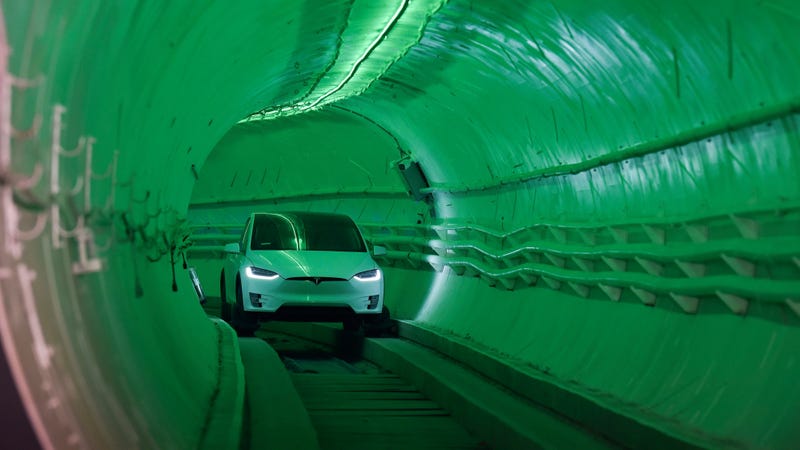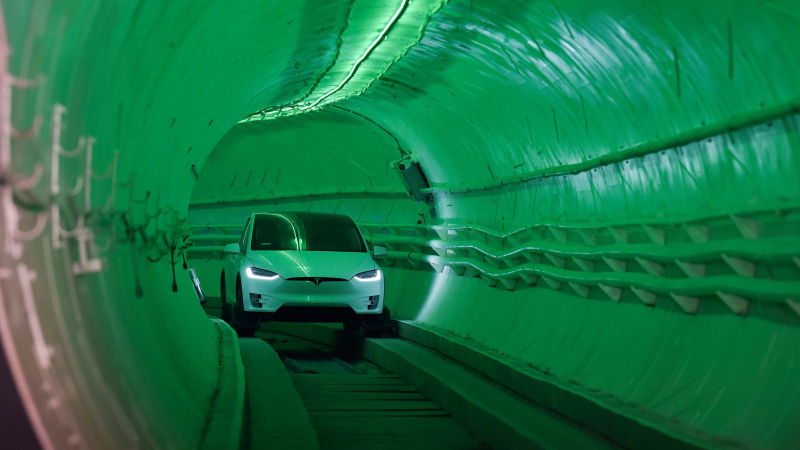
What if I proposed digging two 35-mile tunnels that would begin and end right next to two train stations that currently have service between one another? And this tunnel would be right underneath an existing highway? But this tunnel would be used to skim cars along tracks at speeds no one has achieved yet? And it would move fewer than two trains’ worth of people per direction per day?
You’d probably say something like hey, Aaron, that’s very stupid. And you’d be right.
But what if Elon Musk proposed this?
That’s what a new environmental impact draft report from the U.S. and Maryland Departments of Transportation outline for the much ballyhooed Boring Company tunneling project between Washington, D.C. and Baltimore.
We’ve reached out to The Boring Company for comment on the report, but read in a certain light, the report douses cold water on some of the most optimistic characterizations of the project to date. Instead of zooming hundreds of thousands of passengers from New York to DC in 29 minutes, it assumes they’ll be able to go from DC to Baltimore in 15 minutes, if everything goes well, and maybe at some distant point in the future can be converted to accommodate the theoretical 700 mph Hyperloop that defies space-time.
Advertisement
I say “assumes” because that travel time is dependent on Musk’s car-on-skates tunnel achieving 150 miles per hour, something it has not yet done (even the 45 mph ride was reportedly so bumpy it made people nauseous). And the whole notion of this project’s financially viability depends on The Boring Company digging these tunnels very fast, which in itself is dependent on the company’s “technical progress prior to the start of implementation,” which is a fancy way of saying they haven’t figured that part out yet.
This is no small caveat. 35 miles is a really long tunnel, and they’re not just digging one, but two of them. The report claims a digging time of less than two years, which would be an unprecedented achievement orders of magnitude faster than any other tunneling project to date, as Kevin DeGood, Director for Infrastructure Policy at the Center for American Progress pointed out:
Advertisement
For comparison, a 35-mile twin-bore tunnel through the Swiss Alps took 17 years to build. Yes, digging through the Alps is much harder than the soil beneath Maryland, but not that much harder.
And, for the record, it takes high-speed trains 17 minutes to travel through the tunnel, or only two minutes longer than the proposed travel time in Musk’s DC-Baltimore route.
Advertisement
Even if The Boring Company figures out how to dig tunnels historically fast and propel cars through them at speeds they haven’t done yet, it’s still hard to see how this is a financially viable operation for them without heavy subsidies, something Los Angeles Times transportation reporter Laura Nelson pointed out:
Honestly, it gets exhausting illustrating all the reasons this project is so silly, over and over again, every time some new report or outlandish Musk tweet makes news. There isn’t a single redeeming benefit that isn’t eclipsed several times over by other, existing, proven transit modes.
Advertisement
Want faster trips between DC and Baltimore to reduce traffic on the highways?
Make the existing commuter rail service—which, let me repeat, makes the exact same journey as this proposed tunnel—even remotely efficient, which it is currently not. Or add bus-only lanes on the highways, of which there are currently none.
Want a very rapid premium service between Washington and Baltimore? The Acela already makes the trip in 30 minutes, today, right now. Infrastructure improvements could theoretically make that trip even shorter.
Advertisement
Instead of talking about those things, The US and Maryland DOTs are investing actual resources to study this pointless tunnel and openly advocate for its construction. In a statement accompanying the report’s release, U.S. Secretary of Transportation Elaine L. Chao talked up the potential benefits (heavy emphasis on “potential”):
The publication of a draft environmental assessment for this unique project demonstrates the Department’s commitment to preparing for the future of transportation across all modes.
Advertisement
All modes?! It’s a car in a tunnel! That mode exists!
It’s almost as if the entire project is the brainchild of someone who is not looking to build something for the masses, but to build something for himself, because he hates public transit.
If this is the future of transportation, then let me stay in the past.













